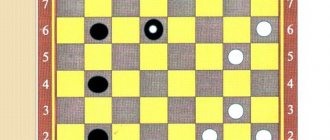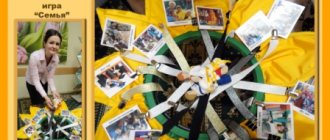The game of checkers, along with chess, is rightfully recognized as one of the most intellectual games. It stimulates:
- mental activity of children;
- develops spatial imagination;
- trains attention and memory;
- develops logic;
- develops communication skills;
- instills perseverance.
When can you start learning to play checkers?
Kindergarten age is considered the most appropriate to begin a step-by-step learning of the rules of the game of checkers. The skills that a child will acquire as a result of the game: to calculate the situation several moves ahead, make important decisions and bear responsibility for them - qualities that will be very useful to him in adult life.
There are several variations of the game in the world - Turkish, English, Italian checkers. They differ in color palette, move options, number of fields and, accordingly, the number of pieces. Let's focus on classic Russian checkers.
Checkers game: rules
- The checkers board for the Russian version of the game consists of 64 squares, painted black and white; the checkers are also black and white. Before the start of the fight, all figures are placed in the bottom three rows against a dark background.
- All moves in the game are carried out only on a dark background.
- The advantage of the first move always belongs to the white pieces.
- The figure moves forward diagonally to any free cell.
- If the player touches a piece, then he must move to it.
- The moves between the opponents alternate.
- If there is an enemy piece in front of the checker, and the field is free after it, then it can be eaten by making a move both forward and backward.
- Walking in the other direction with this position of the pieces is prohibited, even if you expose yourself to a blow
- In one move, if the enemy pieces are positioned well, you can eat several checkers at once.
- If the player managed to reach the opposite end of the board, then he turns over his piece, it turns into a king.
- The queen can move diagonally forward any number of squares. The queen also has access to backward moves.
- Any figure can eat the queen, given the appropriate position.
- The first player to eat all of the opponent's checkers wins.
How to teach a child to play checkers?
- The first lesson should begin with familiarization with the playing field. Let the child first try to arrange the figures correctly on his own; if it doesn’t work, come to the rescue.
- No need to hurry. Play only when the child wants it.
- Don't let your baby become overtired. No matter how interesting your game is, it is necessary to take breaks for physical education.
- Praise, encourage your child, create a situation of success for him, point out the most successful combinations, inspire victories and new achievements.
- Don’t scold if your child doesn’t understand something or makes the wrong move, be more patient.
- Don't give in! If the child wins all the time due to the fact that you have successfully “arranged” everything, then there will be no sense in such a game.
Along with the classic game of checkers, you can teach your child to play “Chapaev” and “Ugolki”. These types of checkers are no less interesting and exciting.
Rules of the game "Corners"
- The player must place a house of checkers.
- One person posts at the top of the board on the right, and the second participant at the bottom left.
- The house is built in the form of a rectangle, 4 pieces are placed in length, 3 pieces in height.
- Using horizontal and vertical movements of checkers, the opponent must arrange moves for himself in order to quickly move all the components to the opponent’s place. You are allowed to jump over one, two or three checkers.
- You can stop the moves yourself at any time.
- The game will be considered over if one of the participants is the first to transfer all the checkers to the opposite place of the opponent.
Explain to your child the strategy for playing corners:
- You need to strive to make several jumps in one move - this way the checker will quickly move to the opposite corner and create conditions for “multi-jump” moves, placing one or more checkers so that you can “jump” over them.
- As soon as possible you need to remove the checkers from your corner, lining them up closer to the center. This creates a barrier that blocks enemy moves. The farther from your home you can place this barrier, the better.
- Try to line up checkers so that the enemy is forced to bypass your barrier in order to gain time.
Pillar checkers (Russian towers)
The rules of Russian post checkers are the same as the usual checkers rules, but with the following differences:
- The opponent's beaten checker is not removed from the board, but is taken under the striking tower.
- If a tower is under attack, then only the top checker is removed from it, after which the checker (or king) that was under it takes over in accordance with its color and rank.
- If several opponent's checkers are fighting, then they climb one after another under the beating piece sequentially during the battle, and a “tower” (“pillar”) is formed on the final field.
- The tower moves all at once and moves according to the rules of its top checker, like a simple checker or queen.
- A tower, like a single checker, can go into kings, with only the top checker becoming a king.
A consequence of the capture rules (1) and (2) is that a player can release his checkers, previously captured by an opponent, and a captured and subsequently released king in the future, as is customary in Russian post checkers, retains the status of a king. (But there is also a variant of the rules, according to which the captive queen becomes simple). The second consequence of the changed rules of the game, since knocked checkers (towers) are not destroyed and are not removed from the board, is a change in the PURPOSE of the game. The goal of the game of pillar checkers is to capture all of the opponent's checkers, as well as to deprive his free checkers (towers) of moves (locking them).
The listed rules are illustrated in the figure. Let's follow the shock move of a white simple checker from field c1 to the final field a7 through intermediate fields a3 and c5. Wherein:
- The top one checker is removed from the black (three-checker) tower on square b2,
- a single checker is taken from field b4 (more precisely, a tower consisting of one checker),
- from a tower consisting of a lower white and an upper black checker and standing on the b6 square, the top black checker is removed and the white checker is freed,
As a result, on the final square a7 a tower is formed from one top white checker and three bottom black ones.
The essence of pillar checkers is defined in different ways. They are sometimes called checkers with the law of conservation of energy; They are also said to represent a peculiar mixture of “strong” checkers and giveaways, since the goal of the game is to capture all the opponent’s checkers, but during “combat operations” tactical and strategic techniques characteristic of giveaways are used to achieve victory.
The strategy of playing towers differs significantly from the well-known strategy of playing checkers: the benefit from capturing certain fields becomes less significant, just as the loss of one or two or even three or four checkers becomes less significant, since they can later be returned to their camp.
But such characteristics of individual towers as:
- tower height - the more of its own checkers enter the tower, the greater the striking force it has (But! An excessive increase in the height of an individual tower leads to the exposure of other sections of the field and, consequently, to a weakening of the position!);
- “negative potential” - a “weak” tower (or a tower with 1-2 of its own checkers on top), holding several of the opponent’s checkers in captivity, can be attacked and turned by the opponent into his own.
The following strategy is quite effective:
- capture as many enemy checkers as possible under your towers, while simultaneously moving towers with a large number of “captive” checkers deeper into your position; attack the enemy with the heaviest towers, while trying to exchange his weakest towers in order to “free” his own pieces.
Fighting techniques known from checkers are also subject to significant revision. If in ordinary checkers blocking the opponent's checkers is a rare and unexpected game technique, then in the tower endgame blocking, in fact, becomes one of the main means of ending the game. All this turns post checkers into an extremely dynamic and unpredictable game.
Rules of the game "Chapaev"
- Each side must place checkers in horizontal rows, 8 pieces in each row.
- The opponent must click his finger on the chips to knock out everything from the opponent.
- The end of the game will be considered when all the opponent's pieces are knocked out.
- The opponent begins his move after one participant loses his piece or fails to knock out someone else’s.
- The player who was the first to knock out all the chips from the opponent moves one row higher in the second round.
In addition to its developmental value, playing checkers instills in children qualities that are important for their future life, such as the ability to think independently and bear responsibility for decisions made, and to deal adequately with failures and defeats. Since most children in preschool age are by nature very mobile and active and find it difficult to concentrate their attention for a long time, playing checkers develops in them such a quality as perseverance.
I hope the article was useful to you and you can easily teach your child to play checkers. I advise you not to forget about playing chess. Good luck!
Where to start learning chess
Learning the wisdom of chess should begin by purchasing a chessboard with pieces or installing a training program on a computer or tablet. To attract the baby’s attention, it is better to select figures of an unusual shape. After this, you need to start practicing as soon as possible, since without practice it is impossible to learn to play chess. To train a young chess player, you can use a computer curriculum with chess exercises.
Original chess
In textbooks, moves are indicated in alphanumeric form, for example, Rd6f-2f. It is deciphered as follows: the first letters mean the name of the piece - rook, the rest are the initial position and the final one, but often indicate only the final one (it’s faster to write this way). In order to correctly read such notes and make the appropriate moves, you need to have letters and numbers marked on the board.
Drawing lesson in the senior group of a preschool educational institution on the topic “Flowers for Mom”
If they are not there, then they must be written next to the cells: vertically - numbers, horizontally - Latin letters. However, self-instruction books from the “Chess for Beginners” series are not suitable for preschoolers.
Important! Teaching young children should begin with beautifully illustrated chess alphabet books or be taught and shown using the example of a chessboard with pieces.
Choosing a tutorial for children and beginners
When choosing a chess textbook, you need to take into account the age of the child. For preschool children, it is better to take a fully illustrated textbook, which simply and clearly shows how a particular figure should move and what the rules of the game are. For children aged 4 to 9 years, a textbook written by Anatoly Karpov is suitable. This small book, created in the form of a comic book, will introduce your child to chess.
A self-instruction manual for children and beginners, written by a famous grandmaster, will introduce you not only to the rules of the game, but will also help you correctly assess the situation. After studying this book, the child will be able to independently place and move the pieces correctly, and even perform simple maneuvers on the board.
However, a self-instruction manual for preschoolers can only teach the rules. Teaching a child to play and win takes practice. The more he plays, the better he understands the features of the game, learns to think, calculate steps (both his own and his opponent’s). Unfortunately, adults need to work and cannot spend all their time with children. A child can gain experience in a chess club of children just like him, under the strict supervision of a teacher.
Sign up for a chess club
You can enroll your child in a specialized section online or directly when visiting an educational institution. In government institutions, admission to the circle is free. Recruitment is carried out from September to May, but you can sign up online at any time.
Important! In addition to state ones, there are also private sections. Private sections are paid, but they may offer services that are not available in regular clubs. For example, individual lessons with a child, with the development of a training program specifically for her.
Features of the mug program for kids
Chess sections are mainly intended for school-age children, so it is located either in a school or in a palace of culture and sports. However, enrolling a preschooler in it will not be a problem, but only if the child is at least 4 years old. For preschool children who have zero knowledge of playing chess, they usually organize a separate place and install special 50-60 cm high chess sets for kids. Training and programs for developing interest in young children under 7 years old differ from programs intended for schoolchildren.
Training and education of children with mental retardation using a correction program
The teacher does not so much teach as introduce children to the world of chess. He tells them interesting stories about chess and explains the rules. At the same time, children can perform simple manipulations with figures. In the first year or two of education, children are introduced to the history of chess and the characteristics of certain pieces. Complex techniques: fork, castling, checkmate and checkmate are taught later when children have mastered the basics.
Children's chess





